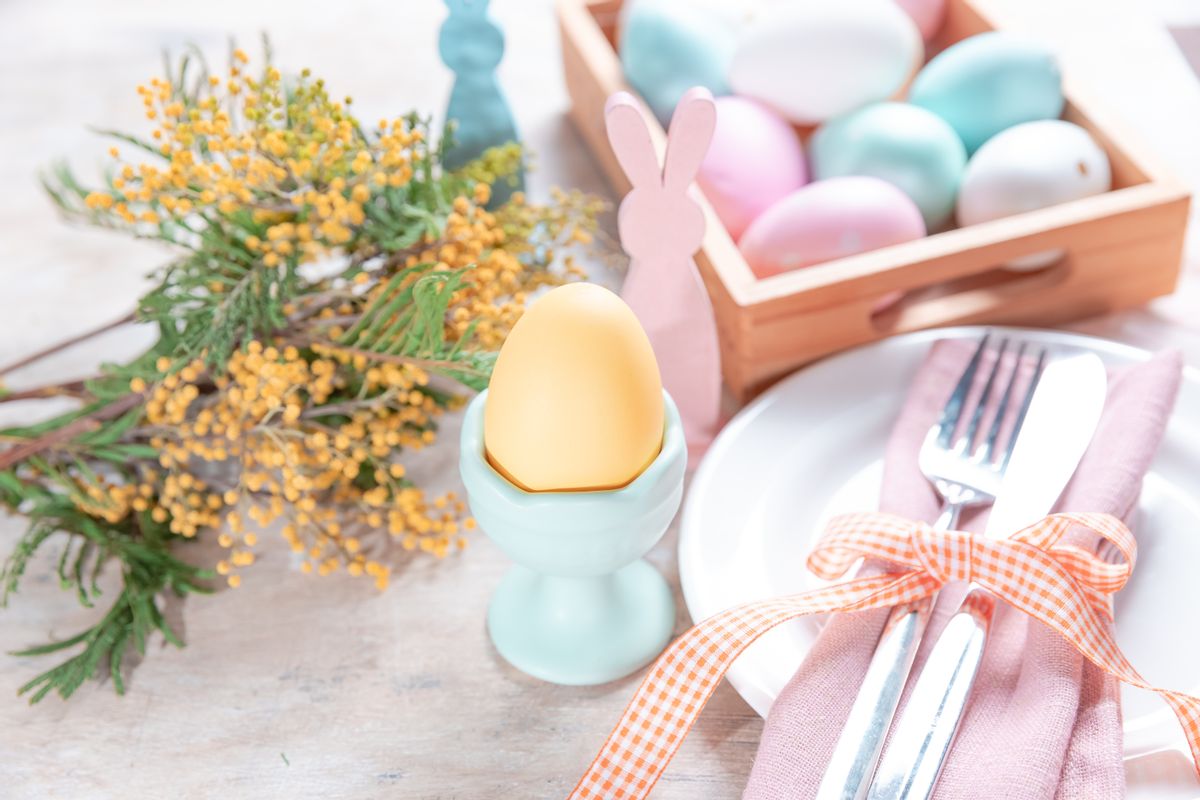Whether you're religious or not, Easter always feels like a celebration of rebirth and spring. Buds begin to form on trees, daylilies start to peek out from the mulch and — after a dark, dark winter — the sunshine finally stays out a little bit longer.
It also marks a shift in how I cook. While winter entertaining often centers on elaborate pasta dishes and braised cuts of meat or slow-roasted veggies, spring is a time to peel back the layers and serve fresh ingredients that are indicative of the season, cooked in such a way that preserves their natural flavors.
This Easter menu offers some updated takes on classics — such as lamb with mint sauce, roasted potatoes and deviled eggs — along with a few simple surprises.
Appetizers
Deviled eggs are an Easter staple and a couple of simple condiment swaps can make them an even more egg-celent addition to your holiday spread. Rather than using your typical mayo of choice, grab the Kewpie.
Related: How to hard-boil eggs to dye for Easter
I've waxed poetic about Kewpie, the original and most recognizable brand of Japanese mayo, before. Unlike its American counterpart, Kewpie is made using just egg yolks, compared to the entire egg. Add a splash of rice vinegar and a hit of umami flavor, and you end up with one of the most craveable condiments on the planet.
Then swap the plain mustard for Inglehoffer Creamy Dill Mustard with Lemon and Capers, which you can find at many specialty markets or order online. It's light and herby, plus you get a little brininess from the capers. Combined, the Kewpie and Inglehoffer make infinitely more flavorful deviled eggs without veering too far from what makes them a classic.
There's nothing worse than starting to prepare for dinner guests and realizing that the one special ingredient you need is missing from your grocery bags. That's why riffable recipes, like this spring pea soup, are the savior of any dinner party.
Want more great food writing and recipes? Subscribe to Salon Food's newsletter.
The general formula is simple: sauté some alliums, add some stock and peas to the pot, swirl in something a little creamy and gently flavor with some herbs or zest. Let the whole thing simmer until you're ready to serve, preferably along with some fresh, crusty bread or toasty croutons.
Why is this dish a winner? It's customizable based on your guests' dining preferences, as well as what you happen to have in your kitchen that day.
Second course
When I was growing up, my family typically ate ham for Easter, but I've come to really appreciate the ease of serving individual lamb chops for the holiday. There's no massive cut of meat to handle or carve (or endless leftovers). As Eric Kim wrote for our friends at Food52, "They take hardly any time at all to come up to temperature in a hot pan (120°F for rare and closer to 145°F for well-done — I prefer the former)."
"Not to mention that lamb, even more than steak, seems somehow more adept at gaining an absolute perfect sear every time, which means you get the best of both worlds: caramelized crust on the outside, juicy rare meat on the inside," he added.
Through the years, mint sauce has gained a reputation for being a little staid and stuffy, but I absolutely love the flavor of mint — especially when paired with savory cuts of meat and veggies. That said, a little update is never a bad thing. This mint sauce is packed with complementary flavors like citrus zest, garlic and red pepper flakes.
Sometimes a slight technique shift can radically change how an ingredient cooks. Case in point: parboiling potatoes before roasting them. As Emma Laperruque wrote for Food52: "Parcook is culinary-school-speak for partially cooking an ingredient, so it can be finished later on. This is useful in restaurants, when an order comes in and you only have a few minutes to make it. And with potatoes, it's even more useful, whether you're in a restaurant or at home."
By doing this, the potatoes get beautifully creamy on the inside and incredibly crispy on the outside. They're perfect with just a little oil, paprika, garlic powder and good salt.
Dessert
"Panna cotta is sort of the Italian version of crème brûlée," Bibi Hutchings wrote for Salon Food. "A key difference between the two is that you use gelatin to make panna cotta. In addition to giving it an amazing mouth feel, this makes serving dessert at exactly the right time easier. When you're ready to dig in, you simply take it out of the refrigerator."
That makes panna cotta ideal for entertaining, too. Dress it with a simple berry compote, fresh spring fruit or a sprig of mint.
More inspiration for your Easter celebration:
- How to cook a spiral ham (and enjoy it for days)
- Italian rosemary buns for a sticky-sweet Easter treat
- This sweet yeasted bread is perfect for Easter brunch
- How to dye the prettiest Easter eggs with pantry staples
- Why Grandma Odette's chicken and rice is the dish I crave every Easter
Salon Food writes about stuff we think you'll like. Salon has affiliate partnerships, so we may get a share of the revenue from your purchase.



Shares